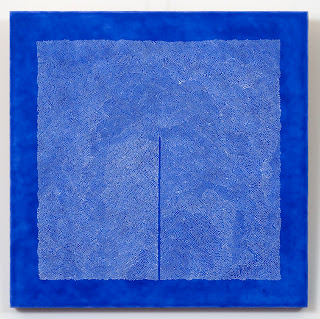Errand Into The Maze
July 22 - September 23, 2016
Art House Gallery
Esperanza Cortes
Sky Kim
Paula Overbay
Gilda Pervin
Every seven years, the Athenians had to send seven young men and seven young women to Crete as a sacrifice for their having killed King Minos’ son Androgeus. Without the ritual, the Athenians would have suffered even greater strife in payment for Androgeus’ death. These youths were never heard of again. They were sacrificed to the Minotaur in the labyrinth at Crete. In the traditional myth of the Minotaur, Theseus was the hero who volunteered to free the Athenians from their fate. With the aid of Ariadne, who fell in love with him, Theseus was able to use a ball of twine she provided to navigate his way out of the labyrinth once he had successfully slain the Minotaur.
In Martha Graham’s dance, Errand into the Maze, Graham moves the focus of the story of the Minotaur away from the hero Theseus and onto Ariadne. Ariadne, was a daughter of King Minos and also the Mistress of the Labyrinth. In her role as Mistress of the Labyrinth, she would dance the maze of the Minotaur. It is here in this Minoan myth that Martha Graham’s interest lies. Graham envisions Ariadne’s encounter with the Minotaur in the darkness of the labyrinth as the awakening of her sexuality and her journey into womanhood. The bull as Minotaur is a lunar symbol (because the curve of his horns resemble the crescent moon) and a symbol of male lust. This is where our exhibition Errand into the Maze takes its theme, from Ariadne’s awakening and the exploration of the unknown. The original 1947 program from the first performance of Graham’s work notes, “The action has its core in that errand-journey into the maze of the heart in order to face and do battle with the Creature of Fear. There is the accomplishment of the errand, the instant of triumph, the emergence from the dark.” The four artists of our exhibition each have created work that speaks to the theme of Ariadne and her experience in the labyrinth.
Esperanza Cortés, with her pieces “Las Desaparecidas”, recalls the disappeared of the world who have lost their lives to the despotic. They symbolize the women lost to the maze and the dangers therein. In the context of the exhibition, they become symbols of Ariadne and her journey to enlightenment; through disappointment and loss to wholeness and strength. “Ojo – Debe Costar Un Ojo De La Cara”, created as an emotional reaction to the destruction of present world terrorism also serves as a nod to the destruction of life ordered by King Minos in the legend of the Minotaur; a disquieting reminder that acts of terrorism are not limited to our own turbulent times. These trials have unfortunately been part of the human story since the beginning of civilization.
 |
| Esperanza Cortes Ojo - Debe Costar Un Ojo De La Cara 2010-2015 150 eye portraits, watercolor on paper, 6' diameter, size variable |
Sky Kim’s labor intensive watercolors have the physical presence of the labyrinth. Through their leafy textures and forms, they recall the diversions of the garden mazes of the Renaissance. The negative spaces in each of the paintings, also engender notions of sexuality, recalling Ariadne’s personal journey.
 |
Sky Kim Untitled Watercolor on paper 40 x 40 inches |
Paula Overbay’s paintings, not only have the visual reminders of the maze, but they imbue the concept of the thread provided by Ariadne to Theseus as his means of return through the complicated passages of the labyrinth. Overbay used as her point of reference the legend of Penelope, who put off her suitors while waiting for Odysseus’ return by weaving a tapestry. Upon the completion of her work, she was to make her choice. But, what she wove during the day, she undid at night and thus staved off a remarriage until her husband’s return. So here the symbol of thread and weaving become intertwined with the maze.
 |
Paula Overbay Bee Line II 2011 acrylic on wood 16 x 16 inches |
Gilda Pervin uses both the sexual imagery of Ariadne’s dance and the crossing pathways of the maze in her works. “Monologues” reminds us, through is expanse and variety, that every woman has her story to tell and each is important and individual. In her assemblages of twigs and other objects, she provides the complicated form of the twisting maze where we can lose our way as we take the wrong direction, when the surety of emerging into the light can turn sinister.
 |
Gilda Pervin Waiting For Dawn burlap, acrylic paint, chinese chestnut, found objects 6 x 8.5 x 2.5 inches |
The maze is not a straightforward symbol of the journey, either of darkness or of spiritual or sexual awakening. Whether we are encountering our personal monsters or seeking the New Jerusalem, the maze is more complicated by the fears that haunt us, or the tools we need for combat. It is an experience that we must live through and emerge transcendent from, if we emerge at all. As Ariadne knew, for each of us who traverse the dark halls to regain the light, there are those who are trapped in the dead ends.
Arthur Bruso • Raymond E. Mingst
Curators


No comments:
Post a Comment